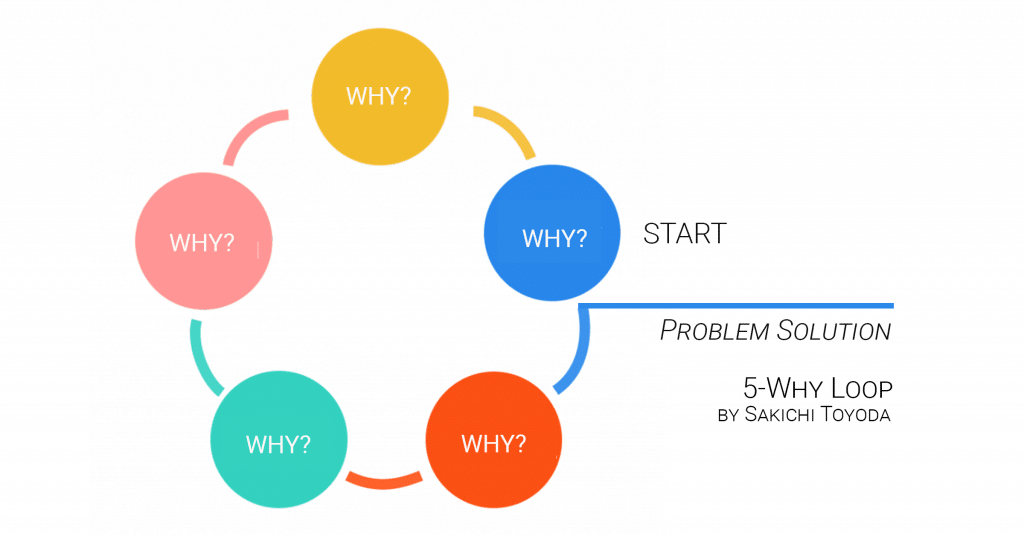Why? How companies ask the right questions

I am always surprised how many companies do not have valid answers to the simple question of “WHY”.
Why do customers buy from us or our products?
For very many companies (B2B and B2C) we know that the real difference of their own offer compared to competitor products in the ecosystem is on average only about 5%, e.g. for men’s jackets and suits, DIY products, insurance offers, kitchen utensils, but also for B2B products.
One simple word.
WHY.
[ˈ(h)wī ]
Adverb
Meaning: for what reason or purpose?
5 times why?
The 5-Why method (also 5-W method) is a brainstorming technique, developed by Toyota founder Sakichi Toyoda and is based, simply speaking, on asking “why” repeatedly until the root cause of a problem is identified.

On average, teams need five “Why?” questions to get to the bottom of any problem. Problems can theoretically be solved with fewer than five, or sometimes with more than five questions.
In any case, the goal is to make sure the problem is understood as well as possible. Once the true cause has been determined, it is easier to solve a problem.

This is a technique that comes naturally to children.
They keep asking “Why?” until they get a satisfactory answer from the person who should obviously know, or until the other person gives up in frustration.
Much to the occasional frustration of the mostly questioned guardians.
It is said that even Albert Einstein used a similar technique.
The question “Why?” is as simply universal as it is essential
It is of fundamental importance for product development and market research.
- WHY do customers like our company?
- WHY do customers buy product XY? Or WHY not?
- WHY do they buy from competitors?and WHY don’t they buy from us?
- WHY do they buy from channel XY and not from YZ?
The why question can only be answered inadequately using classic market research, customer monitoring tools, or social media monitoring.
Most companies know very well where they have to address their potential target customers, how their customer journey works or at least what it should look like, where and what their customers buy or how strong sales channel XY (virtual or stationary) is.
But they don’t know WHY customer XY buys the product or not!
Why not follow the children’s example?
-> Ask the people who should obviously know? Real customers
Because their answers are already available – unused they slumber in external and internal data silos.
Existing customers comment on very, very many topics such as:
- Quality
- Service
- Usability
- Product comparisons
- Brand and brand image
- Brand Awareness
- Trends
- on what they want from products and services
- to ecosystems
- to the market, etc.
And they do this unasked, in their own words. Sometimes more, sometimes less detailed – but always without framing as in surveys, for example. From the gut, quite intuitively.
Hundreds of thousands of texts and data records – written by customers, interested parties, enthusiasts, fans or critics – can be found and automatically analyzed on the Internet for almost any topic, product, or service.
In other words, “REAL” insights that – unlike the common KPIs for measuring customer experience (NPS, CES, CSAT)* – provide information about:
- WHY these customers have bought or not
- WHY they are satisfied or dissatisfied with product XY
- WHY they like the brand/company, favor it over others, or trust the brand.
Why AI?
Today, artificial intelligence can play an outstanding role regarding cross-channel, integrated data management.

Such an AI platform is able to collect all customer information from internal as well as external data silos, to structure it and to display the processed data personalized for the respective company for analysis purposes.
Since the data is available anyway, on the Public Web or in the CRMs / ERPs / emails / support tickets of the companies – the approach is sustainable in the best sense.
Insaas.ai supports SMEs and enterprise companies to specifically find out their “WHY” and based on this to
- significantly improve customer loyalty in their business areas,
- to make existing customer management more successful (up-/cross-selling),
- evaluate new business and sales options (innovations, trends),
- personalize the customer journey comprehensively and in line with customer needs,
- conserve resources and increase own sales.
So let’s get started – let’s ask YOUR target customer group … “Why?”


